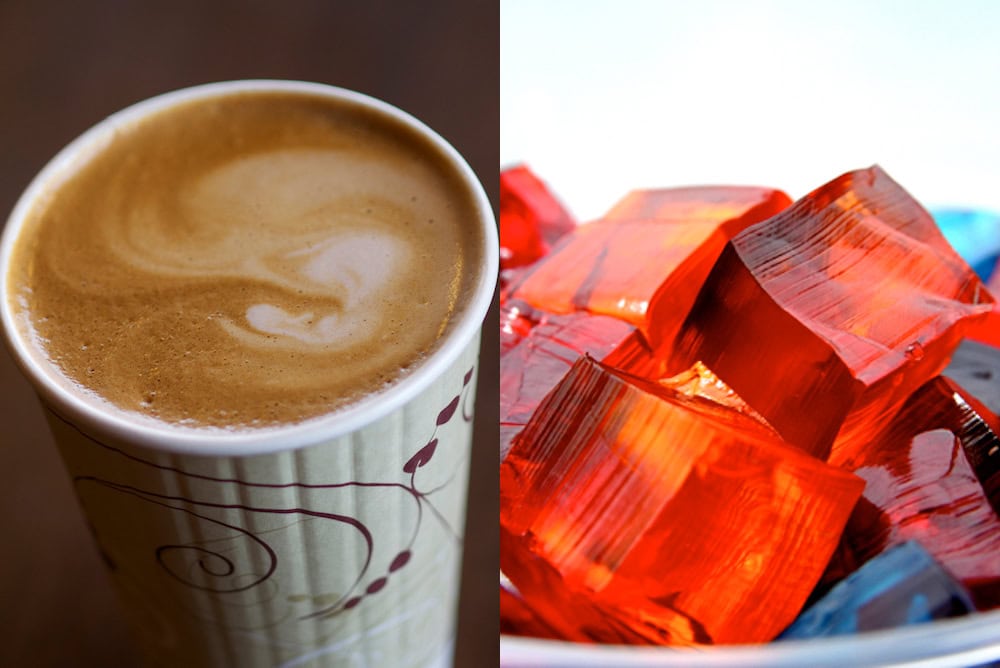
[Images above] Scientists get inspiration for research everywhere, even from everyday food! Credits: David DeHetre, Flickr (left); Steven Depolo, Flickr (right)
It may be a new year, but there is at least one task you already face: finding a way to finish all the leftovers from holiday gatherings.
While fridge cleaning inspires many people to search Allrecipes for a dish containing their random ingredients, food can inspire scientists in quite a different way.
Let’s take a look at two studies that used food as inspiration for research as you sit back, relax, and enjoy your toffee-and-spaghetti dinner.
Jell-O, say hello to new hydrogen fuel catalyst
Be it latkes or mashed potatoes, turkey or ham, one leftover shared by many households wiggles away in a bowl at the back of the fridge: Jell-O!
Jell-O technically refers to a registered trademark of Kraft Foods covering a variety of desserts, but most people associate the name with one particular dessert product—gelatin.
Gelatin is a colorless and tasteless water-soluble protein that does not look or taste very appetizing on its own. But when combined with flavoring, a lot of sugar, and food coloring, gelatin turns into a jiggly dessert that withstands a summer picnic sun thanks to gelatin’s thermal stability and gelatin bloom strength. However, if you instead mix gelatin with water and a metal ion, you get something far more delicious to scientists—a catalyst that generates hydrogen fuel from water just as efficiently as platinum!
“Platinum is expensive, so it would be desirable to find other alternative materials to replace it,” says Liwei Lin, professor of mechanical engineering at the University of California, Berkeley, in a UC Berkeley press release. Lin was senior author of a new UC Berkeley study that found a catalyst based on gelatin splits water molecules as effectively as—and much more cheaply than—the current best platinum-based catalyst.
To create the catalyst, the researchers mixed gelatin and a metal ion—either molybdenum, tungsten, or cobalt—with water, and then let the mixture dry. Lin says the gelatin self-assembles layer by layer as it dries, and because the metal ion is carried by the gelatin, the metal ions also arrange into flat layers. The researchers then heat the mixture to 600°C (1,112°F), triggering the metal ions to react with carbon atoms in the gelatin and form large, nanometer-thin sheets of metal carbide; the unreacted gelatin burned away.
When tested, molybdenum carbide split water most efficiently, followed by tungsten carbide and then cobalt carbide. Mixing molybdenum ions with a small amount of cobalt boosted the performance even more.
“We found that the performance is very close to the best catalyst made of platinum and carbon, which is the gold standard in this area,” says Lin in the press release. “This means that we can replace the very expensive platinum with our material, which is made in a very scalable manufacturing process.”
And here we thought the strangest Jell-O-related news last year was edible Unicorn Slime. Jell-O may soon be on their way to leading clean energy technology, much like Domino’s is taking the lead on fixing potholes across the United States.
The paper, published in Advanced Materials, is “Self‐Assembly of Large‐Area 2D Polycrystalline Transition Metal Carbides for Hydrogen Electrocatalysis” (DOI: 10.1002/adma.201805188).
Coffee rings an idea: MOF-based biosensors
As you chugged pot after pot of coffee to stay awake during holiday party planning and execution, you likely caught yourself multiple times reaching for a coaster to keep your cup from leaving a ring-shaped stain on your nice hardwood table.
While this preventative measure may be the extent to which you thought about the “coffee-ring effect,” researchers at Huazhong University of Science and Technology thought about the effect quite a bit more. They used knowledge of the coffee-ring effect to generate their own “coffee rings”—out of biomimetic metal-organic framework (MOF) films.
The “coffee-ring effect” is the colloquial name for a specific type of capillary flow. Capillary flow is the ability of a liquid to flow in narrow spaces without assistance from—sometimes in opposition to—external forces like gravity. For example, when water “climbs” up the fibers of a paper towel. A coffee cup’s ring-shaped pattern comes from capillary flow caused by different evaporation rates across a drop of coffee: liquid evaporating from the edge of the drop is replenished by liquid from the interior.

Coffee rings are created by a specific type of capillary flow in which liquid evaporating from the edge of the drop is replenished by liquid from the interior. Credit: trophygeek, Flickr (CC BY 2.0)
In the Huazhong study, Hongfang Liu, professor of engineering and director of the Institute of Materials and Environmental Chemistry, and her colleagues at Huazhong University deposited copper(II) hydroxide nanowires in a solvent on hydrophobic graphite-coated paper. As the solvent evaporated, the nanowires self-assembled at the droplets’ edges and formed an oriented net-like structure. The researchers then immersed the structure in 2,6-naphthalenedicarboxylic acid to induce growth between the metal hydroxide lattice and organic linker.
The end product was a sweat sensor that showed high sensitivity and selectivity over a wide testing range, as well as long-term stability. In an Advanced Science News article, author Hannah Muir says the researchers hope the technique could be applied in the next generation of wearable sweat biosensors and other MOF-based wearable electronics.
Now that the holidays are over, grab one more cup of coffee to destress and consider the coffee-ring effect more closely yourself.
The paper, published in Small, is “Coffee Ring–Inspired Approach toward Oriented Self‐Assembly of Biomimetic Murray MOFs as Sweat Biosensor” (DOI: 10.1002/smll.201802670).
Author
Lisa McDonald
CTT Categories
- Material Innovations


